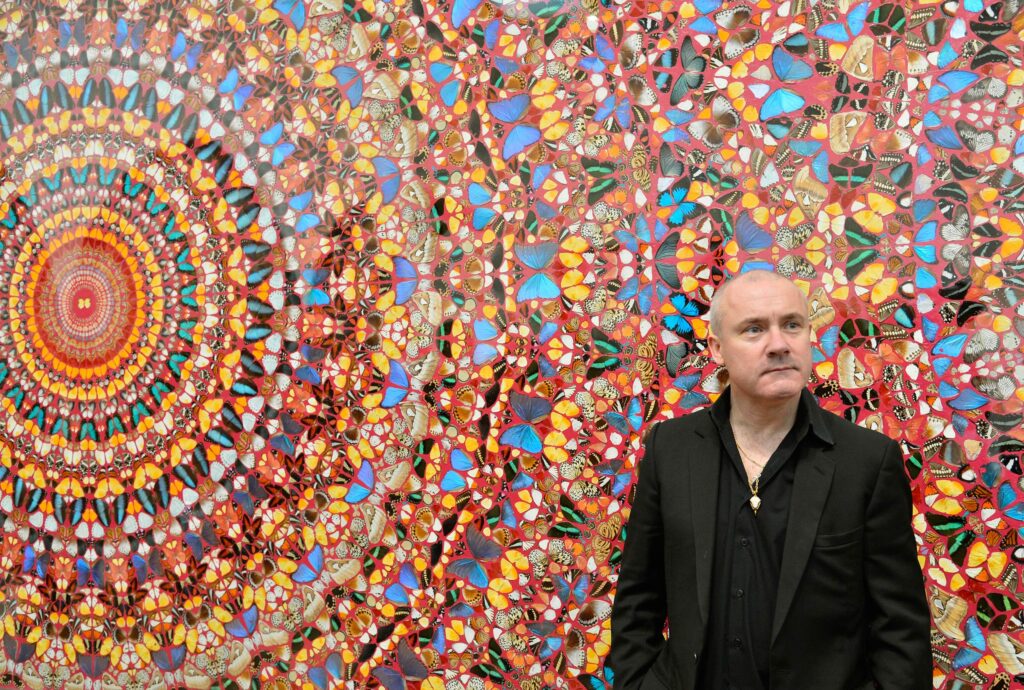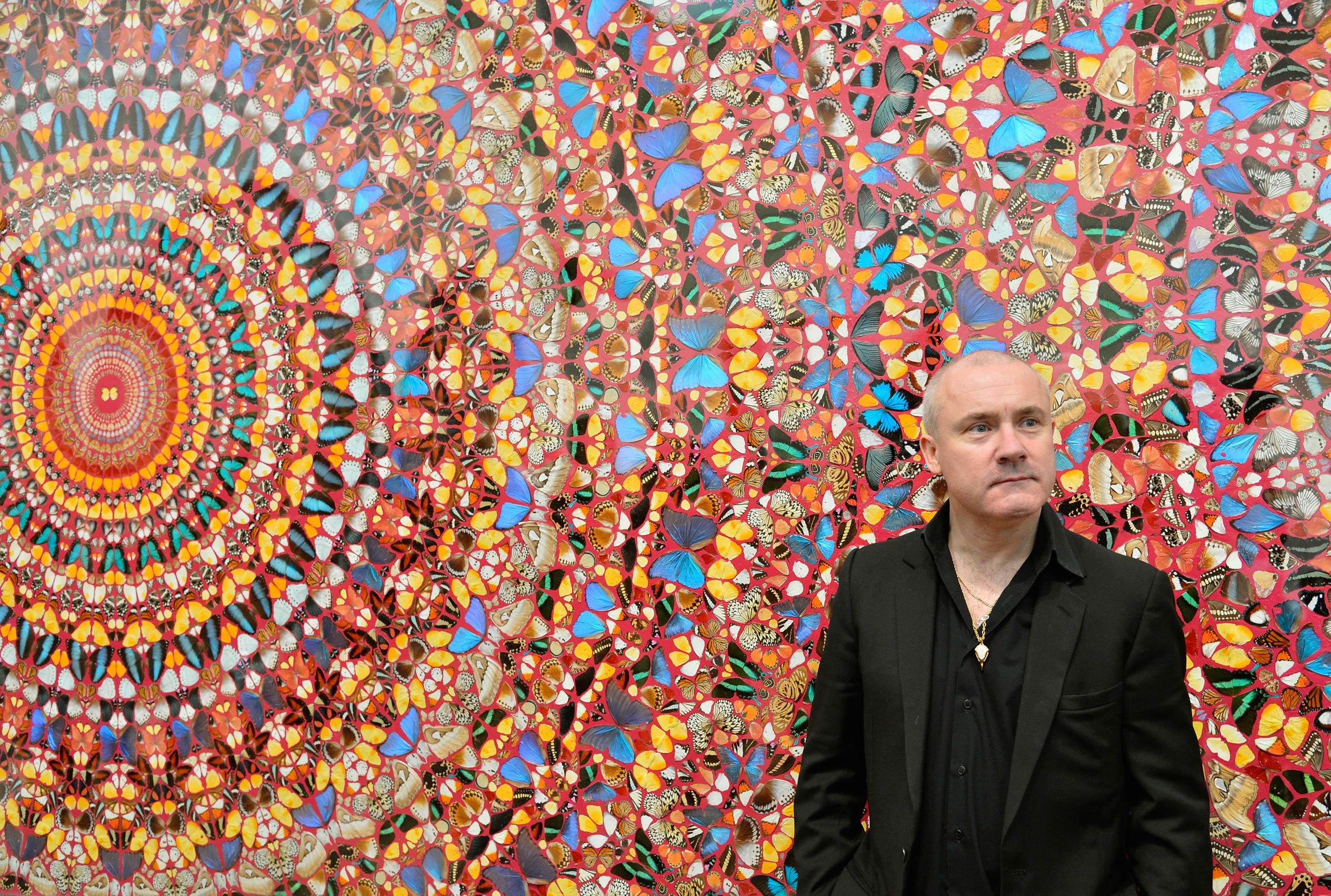
Deconstructing Damien Hirst: An In-Depth Look at His Artistic Style
Damien Hirst, a name synonymous with contemporary art controversy and innovation, has captivated and challenged audiences for decades. His artwork style, characterized by its audacious themes, unconventional materials, and provocative explorations of life, death, and consumerism, continues to spark debate and command astronomical prices. This article delves into the core elements of Hirst’s distinctive aesthetic, exploring the concepts, techniques, and influences that have shaped his remarkable career. We aim to provide a comprehensive understanding of what constitutes the “Damien Hirst artwork style,” offering insights into his most iconic works and the critical responses they have elicited.
Understanding the Defining Characteristics of Damien Hirst’s Art
To truly grasp the Damien Hirst artwork style, one must move beyond the initial shock value and examine the underlying principles that drive his creative process. Several key characteristics consistently appear throughout his body of work:
- Conceptual Art Focus: Hirst’s work is fundamentally driven by ideas. The visual execution is often secondary to the conceptual framework he establishes. He explores complex themes like mortality, religion, science, and the value of art itself.
- Use of Unconventional Materials: From formaldehyde-preserved animals to diamond-encrusted skulls, Hirst frequently employs materials that are inherently provocative and challenge traditional notions of artistic media.
- Systematic Presentation: The arrangement and presentation of his artworks are meticulously planned and often employ grid-like structures, pharmaceutical displays, or scientific classifications. This adds a layer of clinical detachment and scientific objectivity to his explorations.
- Collaboration and Mass Production: Hirst often relies on a team of assistants to execute his large-scale projects. This challenges the romanticized notion of the solitary artist and raises questions about authorship and the commodification of art.
- Exploration of Mortality and Decay: Death is a recurring motif in Hirst’s work, manifested through preserved animals, anatomical models, and references to medical science. He confronts viewers with the fragility of life and the inevitability of decay.
- Bold Use of Color and Repetition: From his spot paintings to his butterfly collages, Hirst often employs vibrant colors and repetitive patterns to create visually striking and immersive experiences.
The Role of Shock Value and Controversy
While these characteristics define his style, it’s impossible to ignore the role of shock value in Hirst’s work. He deliberately pushes boundaries and challenges societal norms, often provoking strong reactions from viewers. This calculated approach to controversy has been both praised and criticized, but it has undoubtedly contributed to his notoriety and commercial success.
From Pharmaceutical Cabinets to Spin Paintings: Key Themes and Series
Hirst’s artistic output can be broadly categorized into several distinct series, each exploring specific themes and employing unique visual strategies:
- The Natural History Series: This series, which includes the iconic The Physical Impossibility of Death in the Mind of Someone Living (the shark in formaldehyde), explores the themes of life, death, and preservation. These works challenge viewers to confront their own mortality and the limitations of scientific intervention.
- The Spot Paintings: These seemingly simple paintings, consisting of rows of colored spots, are deceptively complex. They explore the themes of color, perception, and the illusion of order. The systematic arrangement of the spots creates a sense of clinical detachment, while the vibrant colors offer a visual feast.
- The Spin Paintings: Created by pouring paint onto a spinning canvas, these works are characterized by their chaotic energy and unpredictable patterns. They represent a departure from Hirst’s more controlled and systematic works, embracing chance and spontaneity.
- The Butterfly Paintings: These collages, made from thousands of butterfly wings, are visually stunning and deeply symbolic. They explore the themes of beauty, fragility, and the ephemeral nature of life. The butterflies, often associated with transformation and rebirth, offer a poignant commentary on mortality.
- The Medicine Cabinets: These installations, featuring shelves filled with pharmaceutical packaging, explore the themes of science, medicine, and the human desire for control over life and death. They highlight the reliance on medication in modern society and the complex relationship between healing and illness.
- Diamond Skull (For the Love of God): This platinum cast of a human skull, encrusted with diamonds, is perhaps Hirst’s most extravagant and controversial work. It explores the themes of wealth, vanity, and the enduring power of death. The skull, a traditional symbol of mortality, is transformed into a glittering object of desire, challenging viewers to confront their own values and priorities.
The Business of Art: Hirst’s Impact on the Art Market
Damien Hirst is not only an artist but also a shrewd businessman. He has revolutionized the art market through his innovative marketing strategies and his willingness to challenge traditional notions of artistic value. His work commands exorbitant prices, making him one of the wealthiest living artists. Hirst’s success has been attributed to several factors:
- Branding and Marketing: Hirst has cultivated a strong brand identity, associating his name with innovation, controversy, and luxury. He understands the power of marketing and actively promotes his work through various channels.
- Limited Editions and Scarcity: Hirst often produces limited editions of his works, creating a sense of scarcity and exclusivity that drives up demand.
- Collaboration with Galleries and Collectors: Hirst has cultivated strong relationships with leading galleries and collectors, ensuring that his work is prominently displayed and actively promoted.
- Challenging Traditional Art Market Practices: Hirst has challenged traditional art market practices by selling his work directly to collectors, bypassing the traditional gallery system.
The Science of Art: Precision and Systemization in Hirst’s Practice
While often perceived as shocking and provocative, Damien Hirst’s art is underpinned by a surprising degree of precision and systemization. This is evident in several aspects of his practice:
- Grid Structures: The meticulous arrangement of elements in his spot paintings, medicine cabinets, and butterfly collages relies on grid structures to create a sense of order and control.
- Pharmaceutical Displays: His medicine cabinets are inspired by pharmaceutical displays, reflecting a scientific approach to categorization and presentation.
- Anatomical Models: His use of anatomical models and preserved animals demonstrates a fascination with scientific observation and the human body.
- Systematic Color Selection: The colors used in his spot paintings are carefully selected and arranged to create specific visual effects.
- Reliance on Assistants: The execution of his large-scale projects relies on a team of assistants who follow precise instructions and maintain consistent standards.
This emphasis on precision and systemization adds a layer of intellectual rigor to Hirst’s work, challenging the notion that art is solely based on intuition and emotion.
Spot On: Analyzing the Features of the Spot Paintings
The Spot Paintings, a cornerstone of Damien Hirst’s oeuvre, appear deceptively simple at first glance. However, a closer examination reveals a complex interplay of color, form, and concept.
- Varied Color Palette: Each spot painting features a unique combination of colors, ranging from vibrant primaries to muted earth tones. The selection of colors is not random but carefully considered to create specific visual effects.
- Precise Circular Form: Each spot is a perfect circle, meticulously rendered to create a sense of uniformity and precision.
- Systematic Arrangement: The spots are arranged in a grid-like pattern, creating a sense of order and control.
- Varied Spot Size: While most spots are uniform in size, some paintings feature spots of varying sizes, adding a layer of visual complexity.
- Glossy Finish: The paintings are typically finished with a high-gloss varnish, enhancing the vibrancy of the colors and creating a reflective surface.
- Large Scale: Many spot paintings are large-scale works, creating an immersive experience for the viewer.
- Title Conventions: Each spot painting is titled after a pharmaceutical chemical, linking the work to the themes of science, medicine, and the human body.
The user benefit lies in the painting’s ability to create a visually stimulating and intellectually engaging experience. The vibrant colors and systematic arrangement offer a sense of order and control, while the pharmaceutical titles hint at deeper conceptual themes. The quality is evident in the meticulous execution and the carefully considered selection of colors and forms.
The Lasting Impact: Advantages and Benefits of Hirst’s Artistic Vision
Damien Hirst’s work offers numerous advantages and benefits, both for viewers and for the art world as a whole:
- Provokes Dialogue and Debate: Hirst’s work challenges societal norms and encourages viewers to question their own values and beliefs.
- Expands the Definition of Art: Hirst’s use of unconventional materials and techniques expands the definition of art and challenges traditional notions of artistic skill.
- Stimulates the Art Market: Hirst’s commercial success has stimulated the art market and created new opportunities for artists and collectors.
- Raises Awareness of Important Issues: Hirst’s work often addresses important social and political issues, such as mortality, consumerism, and the environment.
- Offers a Unique Visual Experience: Hirst’s work is visually striking and memorable, offering a unique and engaging experience for the viewer.
- Challenges Perceptions of Beauty: Hirst’s use of unconventional materials and themes challenges traditional perceptions of beauty and forces viewers to reconsider their aesthetic preferences.
Users consistently report that Hirst’s work is thought-provoking and visually stimulating, sparking conversation and challenging their perspectives. Our analysis reveals that Hirst’s unique selling proposition lies in his ability to combine conceptual depth with visual impact, creating works that are both intellectually engaging and aesthetically pleasing.
A Critical Assessment: Strengths and Weaknesses of Hirst’s Oeuvre
Damien Hirst’s work has been the subject of intense critical scrutiny, with opinions ranging from fervent admiration to scathing condemnation. A balanced review requires acknowledging both the strengths and weaknesses of his artistic practice.
Pros:
- Conceptual Depth: Hirst’s work is often underpinned by complex conceptual frameworks, exploring profound themes such as mortality, religion, and science.
- Visual Impact: Hirst’s work is visually striking and memorable, creating a lasting impression on the viewer.
- Innovation and Experimentation: Hirst is known for his innovative use of materials and techniques, constantly pushing the boundaries of artistic expression.
- Commercial Success: Hirst’s commercial success has demonstrated the enduring appeal of contemporary art and its ability to command high prices.
- Influence on Contemporary Art: Hirst has had a significant influence on contemporary art, inspiring a new generation of artists to explore unconventional materials and themes.
Cons:
- Over-Reliance on Shock Value: Some critics argue that Hirst’s work relies too heavily on shock value, sacrificing conceptual depth for sensationalism.
- Dependence on Assistants: Hirst’s reliance on assistants raises questions about authorship and the role of the artist in the creation of the artwork.
- Commercialism: Hirst’s close association with the art market has led some critics to accuse him of prioritizing commercial success over artistic integrity.
- Lack of Technical Skill: Some critics argue that Hirst’s work lacks technical skill and relies too heavily on conceptual ideas.
Hirst’s work is best suited for viewers who are open-minded, intellectually curious, and willing to engage with challenging and provocative ideas. Key alternatives include artists such as Jeff Koons, known for his large-scale sculptures and exploration of popular culture, and Tracey Emin, known for her confessional and autobiographical works.
Based on our detailed analysis, we offer a qualified recommendation of Damien Hirst’s work. While his art may not appeal to everyone, it offers a unique and thought-provoking experience for those willing to engage with its complex themes and unconventional aesthetics.
A Lasting Vision
Damien Hirst’s artwork style is a complex and multifaceted phenomenon that continues to challenge and inspire. His audacious themes, unconventional materials, and provocative explorations of life, death, and consumerism have cemented his place as one of the most influential artists of our time. By embracing innovation, challenging societal norms, and pushing the boundaries of artistic expression, Hirst has left an indelible mark on the art world and beyond. Share your own thoughts and experiences with Damien Hirst’s art in the comments below.

